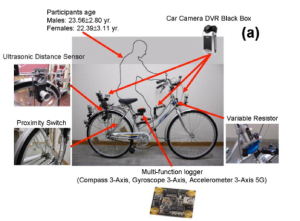The public has spoken so don’t blame me. And it’s nothing to do with Flann O’Brien.
A few days ago I listed three topics I might cover in this post. One was on electromechanical systems for bicycle control. Another was about the dynamics of a peloton. However, both were outvoted by the third option – the medical phenomenon known, loosely, as the cyclist’s third testicle.
Of course, the phenomenon can only manifest itself among half of the world’s population (at most). Nevertheless, the other half, women, may have a vicarious interest and there’s no doubt that some men reading this are driven by similar prurience.
But how many men reading this actually possess the hat-trick of spheres? The chances are higher if you’re a full time, elite professional cyclist than if you’re an occasional leisure rider. It seems that the longer you’re in the saddle, the more likely you’ll develop the titular extra ball.
 To be absolutely honest, it’s not actually a testicle. Not having seen one in the flesh myself, and with no great urge so to do, I’d wager that it doesn’t even look much like a testicle. Yet medics, members of a profession to which we entrust our lives, have branded it a “testicle” so that’s how it shall be known.
To be absolutely honest, it’s not actually a testicle. Not having seen one in the flesh myself, and with no great urge so to do, I’d wager that it doesn’t even look much like a testicle. Yet medics, members of a profession to which we entrust our lives, have branded it a “testicle” so that’s how it shall be known.
In reality, it’s a perineal nodular induration. Before you go scrimmaging in your scrotum to see if that’s what you’ve got, you should know that it is a soft mass. It doesn’t hurt. It doesn’t transmit pain unless maltreated – and who’d want to maltreat such an innocent growth anyway?
It sits just beneath the scrotum. Sometimes it develops as two nodules (as nobody has yet applied the name “fourth testicle” I’ll claim that great privilege right now) but when it is undivided it’s called the third testicle.
The tenth anniversary of its recognition by doctors falls next month, when three (of course) researchers from Belgium published their seminal paper “Perineal Nodular Induration: The Third Testicle of the Cyclist: An Under-Recognized Pseudotumour”.
If you want a third testicle, get a road bike with a very stiff frame, pump the tyres so they are very hard, fit an extremely unforgiving saddle and cycle along a bumpy road for several years. The fatty or collageneous tissue of your perineum will eventually degenerate and form the pseudocyst that you are seeking.
It’s benign, even when it’s the size of an orange, like the one in the photo. Yet if, after you’ve gone to all the trouble of developing it, you find it’s not living up to your expectations, it can be removed. By a surgeon. With a sharp knife. And a steady hand.
*A full year after the above was posted, medics working in the UK have published a paper describing a similar case, in a 57 year old “avid” cyclist, in which they use a term I’d not seen before, “Biker’s Nodule”. You can read the abstract of “An avid cyclist presenting with a ‘third testicle'” here. I hope, for all cyclists’ sake, this isn’t the start of a trend…


